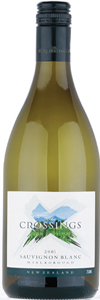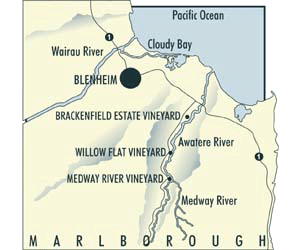 I can’t get enough of that tasty, tasty New Zealand Sauvignon Blanc.Nothing else quite compares; white Bordeaux can come close, with its filigree minerality and level-headed conjoined twin Semillon. Chilean SB is lemony and fun-loving, bright and fresh as a debutante. There are excellent Cali SBs out there, too, though I’m not a Fume Blanc fan these days. But it’s New Zealand that takes this short-lived, sassy grape and gives it a steroid-injected makeover worthy of Oprah and What Not to Wear combined.
I can’t get enough of that tasty, tasty New Zealand Sauvignon Blanc.Nothing else quite compares; white Bordeaux can come close, with its filigree minerality and level-headed conjoined twin Semillon. Chilean SB is lemony and fun-loving, bright and fresh as a debutante. There are excellent Cali SBs out there, too, though I’m not a Fume Blanc fan these days. But it’s New Zealand that takes this short-lived, sassy grape and gives it a steroid-injected makeover worthy of Oprah and What Not to Wear combined.
I had a glass of this wine for $7 at Mars Restaurant, at their new location on South Congress, while sitting on their huge patio on a beautiful Texas late-summer afternoon.The sun was dimpling through the huge live oaks, and it was not sweltering. Divine!
Yellow straw in color.Luxurious nose of sweet gooseberry, perfumed honeydew melon, and very green grass.SweetTart lemony flavor on the tongue evolves into fresh pink grapefruit, with a mineral bite to it of almost-bubbles. A Crystal Light tanginess traipses along the mouthwatering finish. Feels like the Goddess of Spring just slapped my mouth awake with a newly-mown lawn and a bag of Ruby Red grapefruit.
I have always liked The Crossings’ wines; they also make an excellent Pinot Noir. They’re pretty close to the legendary Cloudy Bay winery, arguably the top dog of New Zealand’s SBs.  Certainly one of the reasons I like The Crossings so much is that their wines’ complexity is comparable to Cloudy Bay’s, but at a fraction of the cost. I’ve seen prices for this wine range from $12 to $20 per bottle, but Cloudy Bay is around $40, and that’s when you can find it. Other phenomenal New Zealand SBs (and please realize that I’m a fan, so I love you all) include: Kim Crawford, Brancott for huge value, and Matua Valley.
Certainly one of the reasons I like The Crossings so much is that their wines’ complexity is comparable to Cloudy Bay’s, but at a fraction of the cost. I’ve seen prices for this wine range from $12 to $20 per bottle, but Cloudy Bay is around $40, and that’s when you can find it. Other phenomenal New Zealand SBs (and please realize that I’m a fan, so I love you all) include: Kim Crawford, Brancott for huge value, and Matua Valley.
Early European settlers found a good place to ford the Atawere River somewhere on the estate of the winery, and named the place The Crossings; hence the name of the winery. All of their wines are made from estate-grown grapes. The Crossings has three vineyards in the Valley in Marlborough. Their first wine was released in 2001. The Atawere Valley is glacier-formed, and so they’ve got lots of gravel and not much ground water, all perfect for stressing out grape vines and making high-quality fruit.
Stressed out grape vines = good? You betcha, sister. Some of the best vineyards in the world look like big rockpiles. You see, by limiting the amount of water available to a grape vine, you do a couple of things: you limit the amount of water in the grapes themselves, thereby concentrating the fruit and creating more flavorful wine. Also, you limit the number of leaves on the grapevine, ideally having the bare minimum number to ripen the grapes (think of them as little solar panels, powering the maturation process of the fruit). Too many leaves shade the grapes, resulting in wines that lean too heavily toward vegetal flavors. Research has shown that sunlight on fruit aids in the development of fruity flavors; for example, cabernet sauvignon grown in cloudy climates tends to have more tobacco and green pepper characteristics, whereas cabernet sauvignon grown in sunny areas tends to show more currant and blackberry notes.
You can read other reviews of this wine, though not the 2005, at WineLibraryTV and WineCentric. Also, check out Laurie Daniel’s New Zealand round-up in the San Jose Mercury News. Extra added bonus on the WineLibraryTV episode is Gary’s treatise on screwcaps. Be unafraid! (in the voice of Rob Schneider from Waterboy) You can do it!